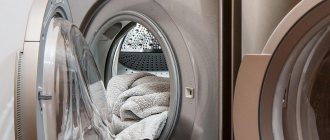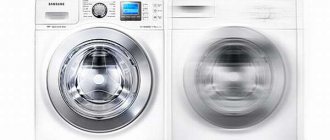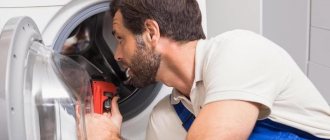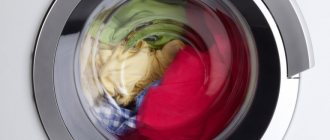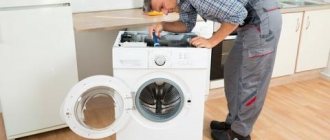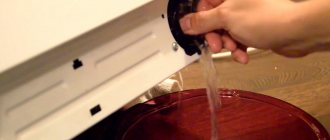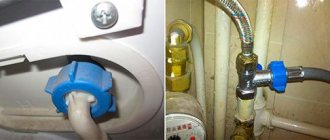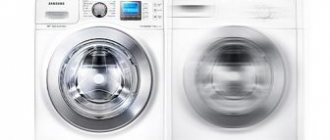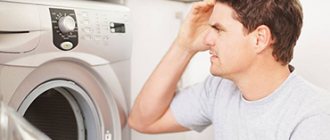Housewives often encounter the fact that the machine vibrates during the spin cycle. Sometimes she just sways, but it also happens that she jumps all over the bathroom, making loud noise and grinding.
The main thing in such a situation is to identify the source of the problem and understand whether it can be solved on your own. Incorrect actions can lead to breakdown of the entire device and flooding of neighbors.
The washing machine jumps during washing - reasons
Vibration of the machine during the spin cycle can be caused by various reasons, the most common of which are discussed below.
Incorrect installation of the washing machine
Improper installation on the floor is one of the common reasons why the washing machine makes a lot of noise and jumps during the spin cycle.
Ideally, the washing machine should stand without tilting or distortion, all legs should touch the surface. The floor should be level and smooth, but not slippery. If these conditions are violated, the automatic machine at high speeds begins to swing towards the slope, shake and make a lot of noise.
Uneven distribution of laundry in the drum
The washing machine jumps during the spin cycle when the laundry is unevenly distributed over the drum area. It can clump together, for example, when small items get caught in a pillowcase. In this case, the entire weight of the wet laundry falls on a small area of the drum, as a result the machine swings strongly in the direction of movement of the resulting lump.
Also, the operation of the equipment may be disrupted due to overload if the weight of the contents exceeds what is allowed according to the instructions. Then the drum cannot rotate at the required speed, and the entire mass of things exerts prolonged pressure on the lower section. When underloaded, the laundry is thrown sharply over the entire available area, which also rocks the washing device.
Transport bolts
Shipping bolts are a fastening mechanism that protects the tank and shock absorber from swinging, wall impacts, and damage during transit. The device works even if the fasteners are not removed, but the washing machine shakes and rattles, and its parts wear out faster.
Spring or shock absorber failure
Shock absorbers, like springs, are designed to dampen tank vibrations that occur when the drum unwinds. Over time, especially with frequent overloads of the machine, these parts wear out.
The shock absorbers are located at the bottom, right under the drum; they are clearly visible if you turn the washer over. Usually there are 2 or 4 of them, depending on the model. The springs are located in front of the tank and behind it. When they are worn out, broken, or the fasteners come off, the machine begins to sway and knock as the tank sags.
Foreign objects
When you spin shirts and dresses in the washing machine, small parts often come off (buttons, decorative bows, patches, bra underwires, pieces of wool, etc.). The torn pieces get stuck between the tank and the drum, causing the equipment to shake.
Loosening the belt
In a number of machines, a special belt goes from the motor to the drum. When power is applied, the motor rotates and with the help of this connecting drive begins to spin the drum. Sometimes the belt wears out, falls off, or its tension becomes weaker, which makes the movements uneven and rocks the structure.
Bearing failure
Bearings are the metal or plastic parts that connect the pulley to the drum. Usually there are two of them: internal and external. They differ in size, distance from the drum and working load.
Under the influence of liquid and a humid microclimate inside the washing machine, the bearings begin to oxidize, and then rust and wear out, and can completely collapse. At the same time, the drum swings freely to the sides when moving and rotates unevenly, turning with difficulty in certain areas. In the most severe cases, it completely jams and water begins to flow from under the machine.
On average, bearings remain operational for 7 years. It is not recommended to use equipment with such damage, as fragments of the part can completely break the washing machine.
Counterweight failure
Counterweights are two heavy concrete or plastic structures that are located in front of the drum and behind it, next to the springs. They are also used to dampen vibrations during movement and ensure the stability of the entire structure. As a result of wear, they can crumble into several parts, or the mounting bolts may fly off.
Problems with the electric motor
Most often, the problem that causes the machine to shake does not lie in the engine itself, but in loose mounts of the electric motor. It is located on the back cover of household appliances. Detection of a fault in the electronic circuitry of a device is only possible for technicians with special equipment.
Imbalance of things
Please note that an imbalance can be caused by either an overload of the drum or an insufficient amount of laundry. It is extremely rare that this situation occurs at optimal loading. This happens due to the fact that things are mixed up and clump together.
It is necessary to stop work and redistribute the laundry. After this, start the push-up mode again. Washing machines from some manufacturers, such as Samsung and LG, have built-in imbalance sensors. And if such a situation occurs, the work stops, and an error is displayed on the display informing about this. Read more about Samsung fault codes here.
Identifying the problem
To determine why the washer jumps during the spin cycle, you must first listen to the sounds it makes:
- if the problem lies in the bearings, then a characteristic grinding noise is heard during movement;
- in the event of a breakdown of the shock absorbers, springs or counterweight, a knock is heard, indicating that the drum is hitting the body;
- when the equipment is not positioned correctly, the laundry is unevenly distributed, or the transport bolts are not removed, the washing machine makes a rumble, but there is no knocking or grinding.
You can try shaking the washing machine. When installed correctly, it should not slide or wobble. You can detect fallen fragments by shining a flashlight through the drum grille. The transport bolts are also easy to find: they are located on the rear wall of the machine.
To determine problems with shock absorbers, you need to put the car on its side and look at it from below. Finding difficulties with counterweights, springs and their fastening requires removing the top and front panels of the device.
Transport bolts
Transport bolts
First of all, we note that this problem is inherent in new washing machines. Or, when moving, bolts were installed and then forgotten to remove. They are installed at the factory to prevent the tank from knocking on the body and being destroyed. After installation at the site of operation, they must be dismantled, because they interfere with the free movement of the tank.
Quite a common situation. Many citizens believe that there is nothing complicated about installing a washing machine and do it themselves. The bolts are not removed, although this is written in the instructions!
Expert opinion
I work in the household appliance repair industry. Extensive experience in restoring washing machines and dishwashers.
Ask a Question
When installing the SMA yourself, remove the transportation bolts!
Troubleshooting yourself
To eliminate some malfunctions, it is not necessary to take the device to a service center; you can do everything yourself. To do this, you need to do the following:
- If foreign objects get behind the drum, you need to bend the rubber seal of the hatch on the front panel, fixing the drum. After this, you should hook the item and pull it out. If you can’t do this, the only thing that will help is removing the heating element and disassembling the automatic machine, which is best left to a professional.
- If the laundry is unevenly distributed, you need to perform an emergency drain of water and unlock the hatch. Next, you should take out the laundry, separate them from each other and carefully place them in the drum. If overload is observed, then remove some of the things from the machine.
- If there is a problem with installation, you need to determine the correct height using a level and adjust the legs of the washer. You can also level the floor or lay down a sheet of chipboard, fiberboard, or anti-vibration pads. Using a rubberized mat will also help if the device slides on the surface.
- If there are transport bolts, you need to turn the machine with the back wall towards you and unscrew 3 or 4 fasteners with a wrench or pliers. In some cases, there are more fasteners, and they are located under the top cover, so it is better to check the instructions first. In their place are installed the plastic plugs supplied. The removed bolts should not be thrown away; they will be useful when moving or rearranging during repairs.
- If you have problems with the shock absorbers, you need to unscrew them and try to compress them. Since their task is to dampen vibrations, movement should be difficult. If this is easy to do, it means that both structures need to be replaced. If only one is corrected, the stiffness will be different and the load will be distributed unevenly.
- If there are difficulties with the counterweights, you need to remove the machine panel (using pliers, a screwdriver, a wrench) and inspect the counterweights. If they crumble, then buy and install new ones. If it is not available for sale, you can tighten the parts with metal plates or glue them together, although this is a rather complicated option. When the counterweights look intact, it is worth examining their mountings, as well as the springs. If they break, they are replaced, but if they are intact, the bolts are tightened.
- To resolve the issue with the electric motor, you need to remove the back panel and try to tighten the fasteners. Also, removing the far cover will allow you to determine the condition of the belt leading from the engine to the drum. Other actions with the motor and the programmable part of the device cannot be carried out independently.
- Bearing failure can only be repaired by a service center.
Adjustment
The machine must be adjusted horizontally. Ignoring this requirement leads to the SMA moving around the room or jumping. This is done by adjusting by screwing or unscrewing. At least two legs out of four are being corrected.
Adjusting the legs
It is also necessary to ensure that they are in close contact with the floor. In the bathroom or kitchen, the surface may be uneven. If you do not adjust the legs for unevenness, this will also lead to the car bouncing.
Important! When installing or moving the SMA, adjust the legs!
Troubleshooting Tips
The following recommendations will help you solve some problems with your machine, which begins to shake during the spin cycle:
- You should always read the instructions first. It indicates the main technical problems and their manifestations, as well as the location of all structural elements.
- If the washing machine is under warranty after purchase, you should not try to disassemble it yourself. These actions may serve as grounds for refusing further interaction on the issue of breakdown.
- Before performing any manipulations, you need to drain the water, then disconnect the device from the power source.
- Finding out the reason for jumping during push-ups should be done in the direction from simple to complex. First, check the installation of the machine, its sliding, and the distribution of the laundry. Then the presence of foreign things in the tank and transport fastenings on the wall. Only after this they begin to inspect the internal parts.
- When disassembling, it is advisable to mark the elements in the sequence of their removal, sketch a drawing of the location, or take photographs of the process so as not to confuse the parts.
- All complex and dangerous actions should be carried out only by specialists. Fixing the problem will cost more, but the machine will work and the owner’s health will remain intact.
Operation errors
Normally, at high speeds during spinning, the washing machine may make rattling sounds and vibrate a little. Despite all efforts, manufacturers cannot make washing machines completely silent. But it is important that during the spin cycle the equipment should not budge significantly, much less jump. Jumping, twitching and frightening swaying make you think there is a malfunction.
Improper operation is one of the most common reasons why a washing machine jumps. It’s sad that most of our compatriots neglect to study the instructions and start the washing machine at random or according to the operating principle of the old one.
Attention! To ensure proper operation of the washing machine in all modes, before starting it for the first time, carefully read the operating instructions!
Overload
The maximum weight of laundry that can be washed in one cycle is often indicated not only in the instructions, but also on the body of the washing machine itself.
Attention! The maximum load is the weight of dry laundry that the equipment can efficiently wash in one full cycle. For example, a 5 kg load is designed for families of up to 3 people, allowing you to wash one or two double sets of bed linen and a couple of bath towels at a time.
The golden rule of washing is to load the drum no more than 2/3, then the clothes will be washed efficiently, there will be no excessive load on the elements of the washing machine, and the weight of the laundry will be distributed correctly when rotating.
If the washing machine has difficulty turning the drum during a cycle, makes strange noises, vibrates strongly or jumps during the spin cycle, the tank is overloaded. In this case, you need to remove unnecessary things:
- Stop the cycle and drain the water.
- Wait for the door to unlock.
- Remove some items and run the rinse and spin cycle.
- If the rumble has passed and the car is standing still, the problem is eliminated. Just don't fill it to capacity in the future.
Uneven or unstable position
A stable position of washing equipment is necessary for the proper operation of all its components. Make sure it is on a level, hard, non-slip surface. If everything is in order, when you press or push the body, the machine will not move and balance on its legs.
You can check how level the equipment is installed using a building level:
- Place it on top of the car.
- Observe the location of the bubble.
- If it is deviated and not strictly in the middle, adjustment is necessary.
Attention! Many models have height-adjustable legs; just unscrew them to the desired length and set the washing machine level.
It is better if the car stands on a monolithic floor that does not “play”, does not slide, and has no unevenness. This is especially important in private homes with wooden floors. Otherwise, during the spin cycle, the machine will continue to jump, and the household appliance itself will last much less than its intended life.
One of the popular solutions is anti-vibration mats and foot pads. They are made of lightweight foam material that can dampen vibrations.
Recommendations for choosing a good washing machine
When purchasing a new washing machine, keep in mind that narrow varieties are more susceptible to vibration. The problem is based on a smaller area of support on the surface and a greater height. Stability, accordingly, becomes lower than that of conventional models. In addition, in a narrow drum, things are more likely to clump together, as a result of which the device suddenly begins to jump.
The more weight of laundry a washing machine can support, the less likely it is to vibrate in situations of overload or lack of space for even distribution. The presence of a belt is equivalent to another assistant for damping vibrations. It is also noted that models with a metal drum make more noise during spinning.
Correctly identifying the problem that is causing the machine to jump will help eliminate it. Characteristics of the sound (dull knocking, grinding or noise during operation) and visual inspection of parts will make it possible to carry out correct diagnostics and identify the source of vibrations.
A number of shortcomings and breakdowns can be eliminated on your own, but resolving issues with the operation of the electric motor and bearings requires the intervention of service center specialists.
How to look for a breakdown?
If you decide to act on your own, then we begin to find out who is to blame and what to do to “calm down” the washing machine. The search for a breakdown should occur sequentially: from the simplest to the most complex. So, first of all, we eliminate the imbalance, which can be dealt with in a couple of minutes. If there is an imbalance, the machine begins to jump furiously, because during the washing process:
- the laundry is crumpled in one place, for example, it got into a hole in the duvet cover;
- the weight of the clothes is above the specified maximum limit for the activated washing program;
- the weight exceeds the loading norm, or, conversely, there are too few things.
The self-diagnosis system of the LG washing machine will signal an imbalance with the error code UE or UB.
During the first wash on a newly purchased machine, a suspicious vibration indicates that the transport bolts have not been removed. They are installed in the machine to secure the drum and must be unscrewed before operating the machine.
Another simple reason is incorrect installation of the machine body. It’s easy to check the machine: just swing the equipment when it’s turned off. If with a slight push the washing machine moves, it means that the problem has been detected. To confirm your guess, you need to measure the position of the unit with a building level.
Next, open the hatch door and use a flashlight to illuminate the tank, while simultaneously rotating the drum. It is likely that a hard object is stuck inside the housing, jamming the motor from spinning. As a result, the machine begins to “walk” around the room and hum.
If at this stage the “culprit” of the shaking is not found, we will have to move on to larger problems. The first thing in line is shock absorption, which should smooth out all mechanical vibrations in the machine. When the dampers are worn out, the machine “jumps” and the drum begins to knock on the walls of the case. A similar knock is heard when the counterweight is weakened. Bearings signal their wear with another sound - a strong grinding sound.
If the washing machine is under warranty, then you cannot hide the body yourself - diagnostics and repairs should only be carried out by a service center technician.
To accurately diagnose a breakdown, you need to remove the top panel of the machine and inspect all the mentioned parts of the washing machine one by one. If no faults are found, then there are two options left: a breakdown in the electric motor or a manufacturing defect. When the problem is found, you can begin repairs - step-by-step instructions are presented below.
Bearings
Bearings
Worn bearings cause vibration and the machine may bounce or move when spinning. This malfunction can be determined by the characteristic noise - rumble, clanging in the area of the rear side, as well as play of the drum. This is a serious breakdown and operation in this condition is extremely undesirable, as it can lead to shaft wear or damage to the tank due to the rotating pulley. Master classes on replacing bearings of various brands of cars can be viewed here: Hansa, Samsung, Zanussi, Bosch, LG.
Cross
Such a breakdown occurs quite rarely. We determine it by the play of the drum, which occurs only in one plane. Repairs can be made. Complete disassembly of the machine and tank will be required. The labor intensity is comparable to replacing bearings.
Washer cross
The problem will be in purchasing the right crosspiece. Get ready for the option - delivery in 2-3 months with prepayment.
Shock absorbers are worn out
Washing machine shock absorbers
It is difficult to predict the lifespan of shock absorbers. It depends on many factors - operating conditions, weight of loaded laundry, number of washes performed. This problem is typical for cars that are not new, older than 5 years. It is possible to impartially determine the need for replacement only when it is removed. We indirectly find out about the presence of wear, in the following way - we pull the tank up and down.
If it drops easily, then most likely the shock absorbers are already damaged and need to be replaced. It is necessary to purchase with a pressure force no less than that indicated in the documentation. Excess is possible, but not more than 20%. Otherwise, this will lead to incorrect operation. And probably the car will also jump and shift, but for a different reason.
You can do the repair yourself if you have the necessary tools and skills. As a rule, to replace it, it is enough to turn the washer on its side.
Expert opinion
I work in the household appliance repair industry. Extensive experience in restoring washing machines and dishwashers.
Ask a Question
Important! When tilting, keep in mind that the control module must always be at the top!
In washing machines of the Indezit, Ariston, Bosch brands, shock absorbers are screwed to the body with screws. In Zanussi and Electrolux, they are fixed with plastic bushings with a latch-type lock, and they cannot be changed without disassembling the case.
